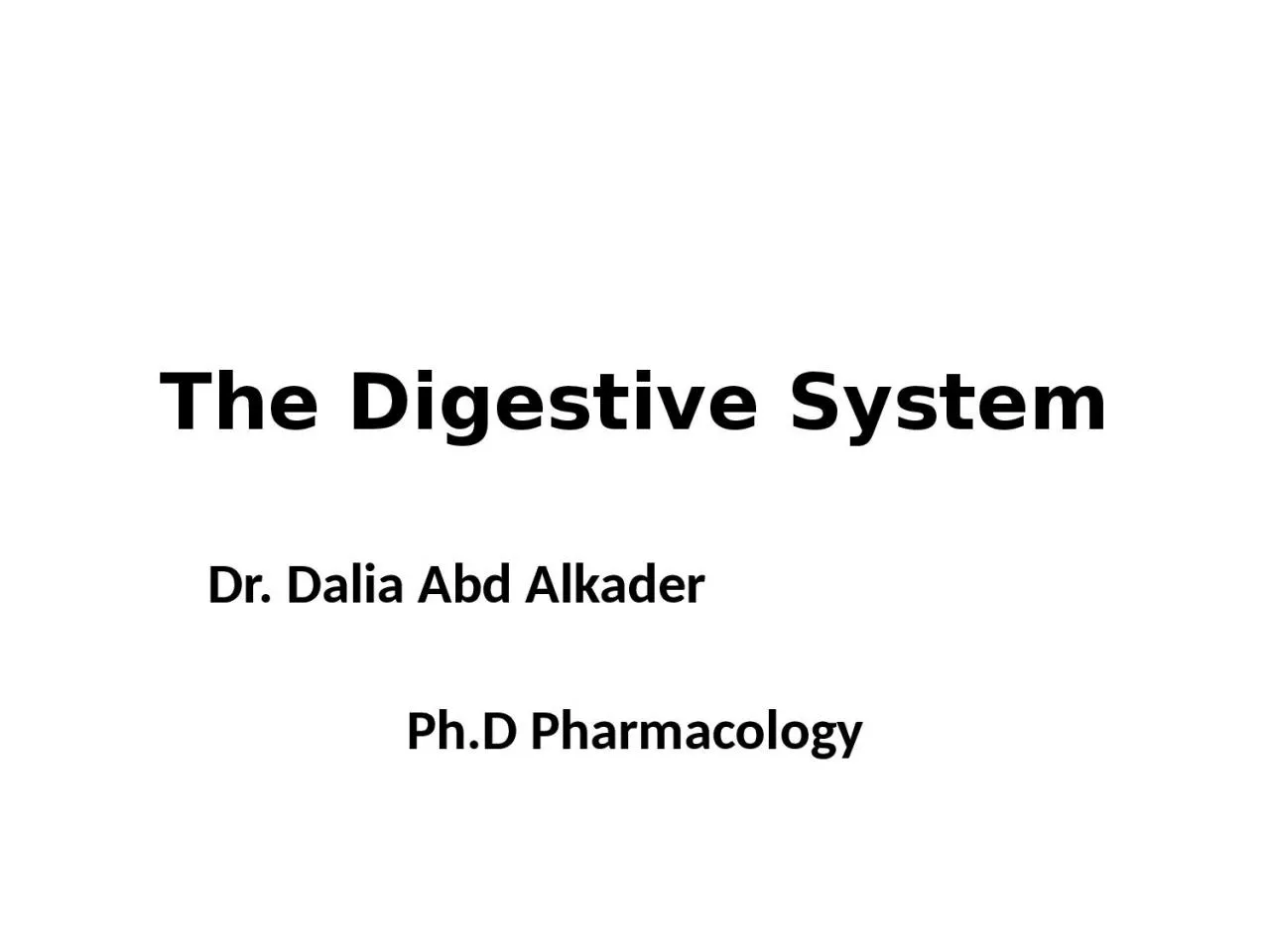

Abd Alkader PhD Pharmacology Word Roots Specific to the Digestive System Root or Suffix Refers to cholecyst o gallbladder duoden o duodenum ID: 915372
Download Presentation The PPT/PDF document "The Digestive System Dr. Dalia" is the property of its rightful owner. Permission is granted to download and print the materials on this web site for personal, non-commercial use only, and to display it on your personal computer provided you do not modify the materials and that you retain all copyright notices contained in the materials. By downloading content from our website, you accept the terms of this agreement.
Slide1
The Digestive System
Dr. Dalia
Abd
Alkader
Ph.D
Pharmacology
Slide2Word Roots Specific to the Digestive System
Root or Suffix
Refers to
cholecyst
/o
gallbladder
duoden
/o
duodenum
enter/o
small intestine
hepat
/o
liver
pancreat
/o
pancreas
phag/o
eating; swallowing
Slide3The Muscular Apparatus of the Digestive System
Digestion starts in the mouth and proceeds through the pharynx, esophagus, stomach, small intestine, and large intestine. The “apparatus” as a whole has several names: alimentary canal, digestive tract, and gastrointestinal (abbreviated GI) tract.
Slide4The Pharynx
The pharynx has “dual citizenship.” It belongs to both the respiratory and digestive systems because it is a passageway for both air and for food and drink. Liquid and chewed food enters the pharynx from the oral cavity, and muscular action sends it to the esophagus.
Slide5The Esophagus
The esophagus is a muscular tube connecting the pharynx with the stomach. It is lined by moist pink tissue called mucosa. The esophagus runs behind the trachea.
Slide6The Stomach
It has four main areas are the
fundus
,
cardia
, body, and
antrum
.
The functions of stomach are:
A
. Temporary storage place for the
food
B
. Secreting acid and enzymes to help
break down proteins, fats, and
carbohydrates.
Slide7Slide8The Small Intestine
Ninety percent of nutrient absorption
occurs in the small intestine, and the
other 10% occurs in the large
intestine.
The first 10 inches of the small
intestine is called the duodenum.
Slide9The segment coming right after the duodenum is the jejunum. The jejunum is the segment from which most nutrients are emptied into the bloodstream. The final segment of the small intestine is called the ileum.
Slide10The Large Intestine
(colon)
Besides absorbing 10% of nutrients, the
large intestine compacts waste material
for elimination.
colon can be subdivided into the
ascending colon, transverse colon,
descending colon, and sigmoid colon.
Slide11Slide12Other Organs of Digestion
The Salivary Glands
There are three separate pairs of salivary
glands, located in different parts of the oral
cavity.
They are called the
parotid
,
sublingual
, and
submandibular
salivary glands. Although
saliva is more than 99% water, it contains
essential enzymes that break down complex
carbohydrates. Saliva also contains
antibodies that kill bacteria.
Slide13Slide14The Pancreas
The pancreas acts as both an endocrine and an exocrine gland. The pancreas provides insulin directly to the bloodstream (endocrine function) and secretes a fluid containing enzymes into the small intestine (exocrine function). Both of these pancreatic secretions are essential to digestion.
Slide15The Liver
The liver keeps the body's metabolism balanced and promotes good health by releasing fat-soluble vitamins, such as A and D, when the body needs them.
The liver also produces bile, which helps in breaking down the lipids (fats).
Slide16The Gallbladder
It is a small pouch that locates just under the liver. The gallbladder stores bile produced by the liver and delivers it to the small intestine.
Slide17Slide18Common disorders and procedures associated with the digestive system
Term
Definition
cholecystectomy
excision of the gallbladder
cholecystitis
inflammation of the gallbladder
colitis
inflammation of the colon
enteritis
inflammation of the intestine
enterospasm
painful peristalsis
Slide19gastrectomy
excision of part of the stomach
gastritis
inflammation of the stomach
hepatitis
inflammation of the liver
pancreatitis
inflammation of the pancreas
enterogastritis
inflammation of the intestine and stomach
enterostenosis
narrowing within the intestinal tract
Slide20Common Abbreviations:Abbreviation Meaning
DM diabetes mellitus
GB gallbladder
GERD
gastroesophageal
reflux
disorder
GI gastrointestinal
NGT
nasogastric
tube